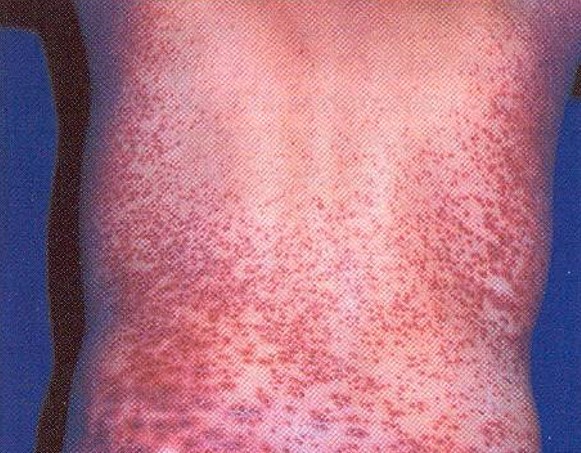You have recieved your COVID19 immunizations and have returned to your outpatient
practice. However, you are still doing telemedicine and are presented a case of a
35-year-old man who became ill while visiting his relative in Kenya, Africa. Two
weeks into his visit he noted the sudden onset of fever up to 40° C, headache, retro-orbital
pain, nausea, and diffuse myalgias and arthralgias, and a rash on his face, neck and
trunk (see photograph below).
What is you diagnosis, what test(s) would you order to confirm your suspicions,
and what treatment, if any, do you recommend?

DIAGNOSIS: Dengue. The Dengue virus (DV) is endemic throughout the tropical and
subtropical zones between 30° N and 40° S where environmental conditions are optimal
for the DV vector, the Aedes mosquito; transmission within this area occurs throughout the year, accounting for
about 100 million symptomatic dengue infections per year. The most affected areas
include Southeast Asia, Latin America, the Caribbean, and Africa.
Dengue has a wide spectrum of clinical manifestations, ranging from asymptomatic
to severe disease, varying according to the infecting virus (DV1, DV2, DV3, or DV4),
epidemiology, immune status, genetic makeup, and previous infections with DV or other
flaviviruses (i.e., ZIKA). The incubation period of DV ranges from 5-7 days.
The frequency of symptomatic DV infection is about 10% . The initial febrile phase
lasts about 4-7 days and is characterized by fevers up to 40°C, headache, retro-orbital
pain, nausea, vomiting, myalgias, and arthralgias. A faint morbiliform rash with or
without petechiae and ecchymoses occurs in about 50% of cases. There may be "islands"
of spared skin (see patient's rash above).
Following the febrile phase, the patient may recover or may develop a one- to three-day
critical phase which is characterized by an increase in capillary permeability, massive
plasma leakage, and intravascular volume depletion that can lead to end organ failure,
shock and death. This critical phase is antibody dependent and most likely, therefore,
to occur in those that have a previous history of DV infection.
During the first week of infection the diagnosis can be confirmed by detecting
circulating levels of DV RNA using RT-PCR and by detecting DV non-structural protein
1 (NS1) by ELISA. Rapid tests combining NS1 and antibody detection are also available.
The treatment of DV infection is supportive with close monitoring required until
the patient has fully recovered.
 South Dossett Drive - Closure...
South Dossett Drive - Closure...